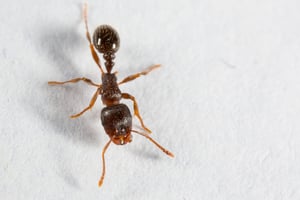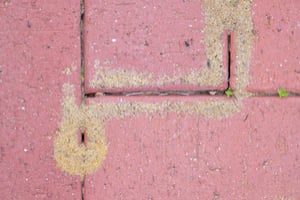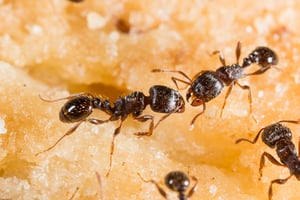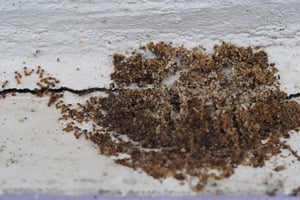Common ants like pavement ants aren’t dangerous pest infestations, but that doesn’t make them any less annoying. When you’re dealing with an ant infestation, it can feel like you just can’t get away. Whether you’re outside or inside, the ants will find you, and they will ruin your picnic. Metaphorically or literally. If you’re running into all kinds of little black ants this summer, chances are they’re probably pavement ants. Pavement ants are often mistaken for sugar ants or house ants, but they’re slightly different. Here’s everything you should know about the ants marching into your home, including how to march them right back out.
What are pavement ants?
 Pavement ants (Tetramorium caespitum) are one of the most common pest insects encountered all over the US. They are often mistaken for sugar ants or house ants. Pavement ants are small (⅛ inch) ants that are brown, red-brown, or black. Like most ants, they have six legs, a segmented body (head, abdomen, segmented pedicel, thorax) and a large posterior thorax. Parallel “furrows” or lines run across pavement ant heads and thoraxes.
Pavement ants live together in large supercolonies, in which the ants develop into specialized castes. Pavement ant colonies consist of workers, reproducers, and a Queen. Workers are the most typically-encountered pavement ants. All workers are non-reproductive females and possess dorsal spins and a rear stinger. These stingers are used to apply trailing pheromones to communicate with other workers, not defense. Reproductive pavement ants look similar to workers, but they’re about twice as large and they have wings.
Pavement ants (Tetramorium caespitum) are one of the most common pest insects encountered all over the US. They are often mistaken for sugar ants or house ants. Pavement ants are small (⅛ inch) ants that are brown, red-brown, or black. Like most ants, they have six legs, a segmented body (head, abdomen, segmented pedicel, thorax) and a large posterior thorax. Parallel “furrows” or lines run across pavement ant heads and thoraxes.
Pavement ants live together in large supercolonies, in which the ants develop into specialized castes. Pavement ant colonies consist of workers, reproducers, and a Queen. Workers are the most typically-encountered pavement ants. All workers are non-reproductive females and possess dorsal spins and a rear stinger. These stingers are used to apply trailing pheromones to communicate with other workers, not defense. Reproductive pavement ants look similar to workers, but they’re about twice as large and they have wings.
Where did these pavement ants come from?
 Experts believe the ants were accidentally transported to the US on merchant's vessels during the 1700s and 1800s. Before traveling to America, European merchants filled their ships with soil to weigh down for the overseas voyage. Upon arrival, they had to dispose of this soil to make room for the goods they were taking back home. Unfortunately, when they dumped the soil, they were accidentally dumping the ants inside it, too!
Pavement ants are most active during summer, particularly during their May to July breeding season. They may also attempt to enter homes in fall to stay warm over the winter. Pavements ants usually nest under sidewalks, driveways, stones, logs, and other concealed sites. They may also make nests under homes, especially under concrete foundations or wooden floorboards. Outside, it’s common to see signs of nest excavation like sand piles or soil particles near cracks in concrete.
Experts believe the ants were accidentally transported to the US on merchant's vessels during the 1700s and 1800s. Before traveling to America, European merchants filled their ships with soil to weigh down for the overseas voyage. Upon arrival, they had to dispose of this soil to make room for the goods they were taking back home. Unfortunately, when they dumped the soil, they were accidentally dumping the ants inside it, too!
Pavement ants are most active during summer, particularly during their May to July breeding season. They may also attempt to enter homes in fall to stay warm over the winter. Pavements ants usually nest under sidewalks, driveways, stones, logs, and other concealed sites. They may also make nests under homes, especially under concrete foundations or wooden floorboards. Outside, it’s common to see signs of nest excavation like sand piles or soil particles near cracks in concrete.
What do pavement ants want?
 Pavement ants are opportunistic foragers. Workers scavenge food from wherever they can and carry it back to the colony. The ants feed on a wide variety of food, including grains, grease, seeds, dead insects, fruit, nectar, and syrups. They’re particularly fond of sweets, which is why they’re often mistaken for sugar ants. They’re also mistaken for house ants when homeowners encounter them inside stored food items like bread or sugar. Like other ants, pavement ants are also attracted to sources of moisture.
The name “pavement ant” comes from this species’ tendency to build nests under pavement and sidewalks. Driveways, concrete, sidewalks, and rocks provide pavement ant nests with important natural cover and concealment from predators. Pavement ants look for cracking or damaged concrete structures where they can build their nests. During the summer, they’re often content to build their nests outside, though they may still enter structures to forage. Pavement ants can build nests indoors, however, and if they do they can remain active all winter.
Pavement ants are opportunistic foragers. Workers scavenge food from wherever they can and carry it back to the colony. The ants feed on a wide variety of food, including grains, grease, seeds, dead insects, fruit, nectar, and syrups. They’re particularly fond of sweets, which is why they’re often mistaken for sugar ants. They’re also mistaken for house ants when homeowners encounter them inside stored food items like bread or sugar. Like other ants, pavement ants are also attracted to sources of moisture.
The name “pavement ant” comes from this species’ tendency to build nests under pavement and sidewalks. Driveways, concrete, sidewalks, and rocks provide pavement ant nests with important natural cover and concealment from predators. Pavement ants look for cracking or damaged concrete structures where they can build their nests. During the summer, they’re often content to build their nests outside, though they may still enter structures to forage. Pavement ants can build nests indoors, however, and if they do they can remain active all winter.
What can I do about a pavement ant infestation?
 Pavement ants enter your home seeking food and water. If you can deprive them of those resources, they’ll leave you alone. Find and patch up any stray plumbing leaks, especially in and around your kitchen. Thoroughly clean food prep and dining areas after every meal. Make sure you properly seal and store all food, especially sweets and pantry goods. Keep a close eye on spills and crumbs. Pavement ants don’t need much, and they’ll take whatever they can get.
After you’ve eliminated attractants, try to find how the ants are getting into your home. Pavement ants generally move in long, single files lines called “trails.” Follow these trails back to their source to find access points. Seal these access points with caulk or steel wool. Consider leaving out ant poison in areas where you commonly see ants traveling. Pavement ants will take the ant poison back to their nest for food, where it could wipe out the colony.
Pavement ants are among the most commonly-encountered ants in North America, especially during summer time. If you’re having an ant problem, the pests you’re dealing with are probably pavement ants. By following these tips, you can track them down and drive them out.
If you’re worried about the pavement ants in your home, now’s the time to act! Don’t let a colony establish itself in your home for the winter. If you want some help wiping out your pavement ant problem, call Plunkett’s any time. We’ll kick your ants to the curb… and then we’ll keep kicking them until they’re far away from your pavement!
Pavement ants enter your home seeking food and water. If you can deprive them of those resources, they’ll leave you alone. Find and patch up any stray plumbing leaks, especially in and around your kitchen. Thoroughly clean food prep and dining areas after every meal. Make sure you properly seal and store all food, especially sweets and pantry goods. Keep a close eye on spills and crumbs. Pavement ants don’t need much, and they’ll take whatever they can get.
After you’ve eliminated attractants, try to find how the ants are getting into your home. Pavement ants generally move in long, single files lines called “trails.” Follow these trails back to their source to find access points. Seal these access points with caulk or steel wool. Consider leaving out ant poison in areas where you commonly see ants traveling. Pavement ants will take the ant poison back to their nest for food, where it could wipe out the colony.
Pavement ants are among the most commonly-encountered ants in North America, especially during summer time. If you’re having an ant problem, the pests you’re dealing with are probably pavement ants. By following these tips, you can track them down and drive them out.
If you’re worried about the pavement ants in your home, now’s the time to act! Don’t let a colony establish itself in your home for the winter. If you want some help wiping out your pavement ant problem, call Plunkett’s any time. We’ll kick your ants to the curb… and then we’ll keep kicking them until they’re far away from your pavement!






